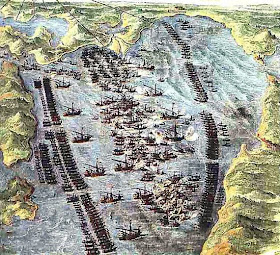No séc. XVI as esquadras do Império Otomano pretenderam tranformar o Mediterrâneo no se Mare Nostrum. Para combater a expansão muçulmana formou-se a Liga Santa (Holy League) (Heiligen Liga) no campo Cristão. Filipe II de Espanha nomeou seu irmão D. Juan de Austria, capitão general das Forças Reais. Os restantes comandantes eram: Sebastiano Venier (Veneza) e Marcantonio Colonna (Estados Papais). Miguel Cervantes Saavedra perdeu o braço esquerdo, donde a designação 'el manco de Lepanto'; depois esteve cativo em Argel. Apesar da derrota no Golfo de Patras (Mar Jónico), nos arredores de Naupaktos, os Otomanos conquistaram parte do Norte de África.
In the 16th century police stations of the Ottoman Empire wanted to transform the Mediterranean into the Mare Nostrum. To combat the Muslim expansion was formed the Holy League (Heiligen League) in the Christian. Philip II of Spain appointed his brother D. Juan de Austria, captain general of the Royalist forces. The other commanders were: Sebastiano Venier (Venice) and Marcantonio Colonna (Papal States). Miguel Cervantes Saavedra lost his left arm, hence the name 'el manco de Lepanto' and then was captive in Algiers. Despite the defeat in the Gulf of Patras (Ionian Sea), on the outskirts of Naupaktos, the Ottomans conquered part of North Africa.
Anónimo-'the victors of Lepanto'-öl auf Leinwand Wien-Kunsthistorisches Museum Gemäldegalerie
Paolo Caliari or Paolo Veronese (1528-1588)-'The battle of Lepanto'-oil on canvas
Yogesh Brahmbhlatt-'The battle of Lepanto'-oil on canvas Greenwich-National Maritime Museum (BH CO 261)
Fernando Bertelli (1505- )-'The battle of Lepanto'-oil on canvas-1572 Venezia-Museo Storico Navale
Tiziano Vecelli (1490-1576)-'Allegory of the battle of Lepanto'-oil on canvas-ca 1575 Madrid-Museo del Prado





No comments:
Post a Comment